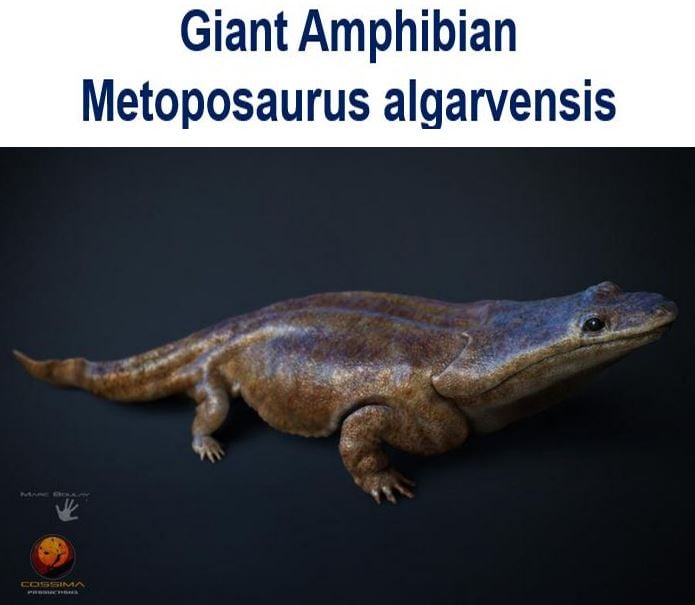A distant relative of today’s salamanders, a massive crocodile-like amphibian that existed during the rise of the dinosaurs over 200 million years ago, was a top predator, researchers in a study led by the University of Edinburgh reported.
Study leader, Dr. Steve Brusatte, of the University of Edinburgh’s School of GeoSciences, and his team of palaeontologists discovered the existence of the giant newt-like creature after excavating bones in southern Portugal on the site of an ancient lake.
The species – Metoposaurus algarvensis – belonged to a wider group of early amphibians that were common at low latitudes between 220 and 230 million years ago, the researchers said.

A model of Metoposaurus algarvensis. (Credit: Marc Boulay, Cossima Productions)
The latest finding has been published in the academic journal Journal of Vertebrate Paleontology.
Metoposaurus algarvensis grew to a length of up to 2 metres (6ft 7ins) and lived in rivers and lakes during the Late Triassic Period. Its lifestyle and diet were similar to that of modern crocodiles. It fed mainly on fish, the authors wrote.
Coincided with the rise of the dinosaurs
The species lived at the same time as the first dinosaurs appeared and started to dominate the food chain, a reign that lasted for more than 150 million years.
Modern amphibians, including newts and frogs evolved from these primitive amphibians.
This group of amphibians was more geographically diverse than scientists had previously thought. Metoposaurus algarvensis was a distant relative of the salamanders of today, the team said.
Fossils of the species this latest find belonged to have been found in parts of North America, India, Europe and Africa. The palaeontologists realized the fossils discovered in Portugal belonged to another species because of differences in their skull and jaw structures.
The researchers say the new species was discovered in a large bed of bones where several hundred of these amphibians may have died when the lake dried up.

Metoposaurus algarvensis skull fossils. (Credit: Octavio Mateus, Richard Butler, and Steve Brusatte)
Team hopes to find more specimens
Only about 4 square metres of the site has been excavated so far. The scientists believe there are many more fossils to be found there.
Most members of this group of species were wiped out about 201 million years ago during a mass extinction, a very long time before the fall of the dinosaurs.
The end of the Triassic Period, when most of these creatures disappeared, marked the end of the Triassic Period. At this time, the supercontinent Pangea – which included all of Earth’s present day continents – started to break apart.
The mass extinction wiped out several groups of vertebrates, including the large amphibians, which allowed the dinosaurs to become the dominant predators.
A fearsome creature
Dr. Brusatte said:
“This new amphibian looks like something out of a bad monster movie. It was as long as a small car and had hundreds of sharp teeth in its big flat head, which kind of looks like a toilet seat when the jaws snap shut.”
“It was the type of fierce predator that the very first dinosaurs had to put up with if they strayed too close to the water, long before the glory days of T. rex and Brachiosaurus.”
Dr. Richard Butler, who works at the School of Geography, Earth and Environmental Sciences at the University of Birmingham, said:
“Most modern amphibians are pretty tiny and harmless. But back in the Triassic these giant predators would have made lakes and rivers pretty scary places to be.”
During a series of events at the Edinburgh International Science Festival (April 4th to 19th), Dr. Brussatte will discuss his research, the recently discovered species, and other aspects of palaeontology.
The study was funded by the Municipality of Loulé, Camara Municipal de Silves and Junta de Freguesia de Salir in Portugal, the German Research Foundation, the National Science Foundation, Columbia University Climate Center, the Jurassic Foundation, CNRS, and the Chevron Student Initiative Fund.
Citation: “A new species of Metoposaurus from the Late Triassic of Portugal and comments on the systematics and biogeography of metoposaurid temnospondyls,” Stephen L. Brusatte, Richard J. Butler, Octávio Mateus and J. Sébastien Steyer. Journal of Vertebrate Paleontology. Published online 23 March, 2015. DOI: 10.1080/02724634.2014.912988.
